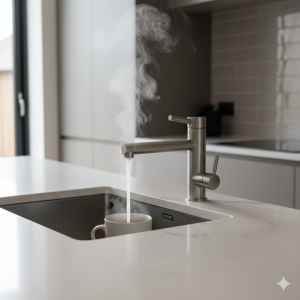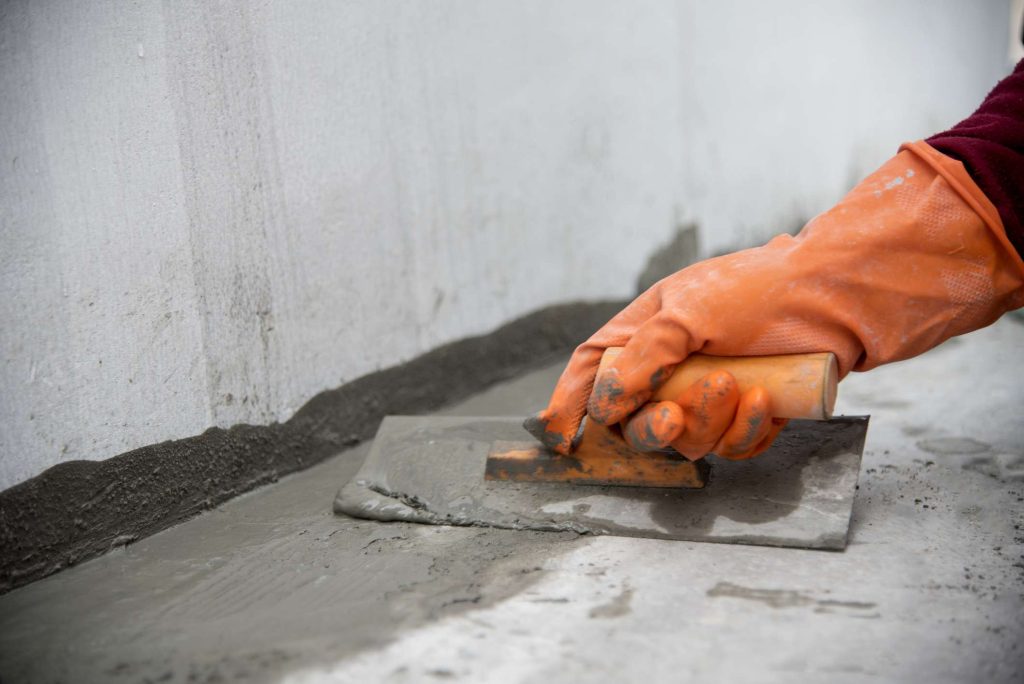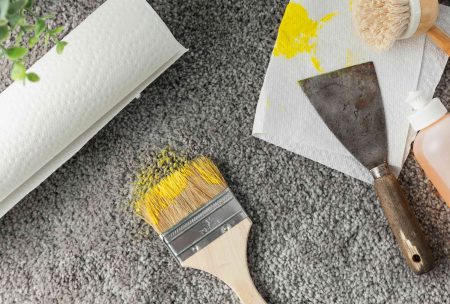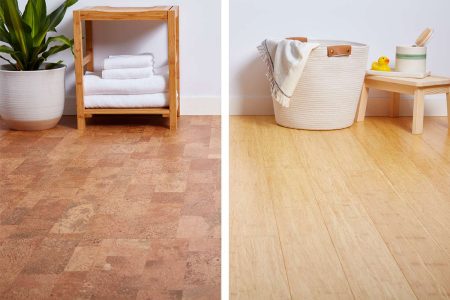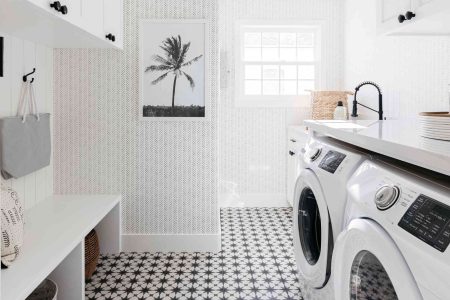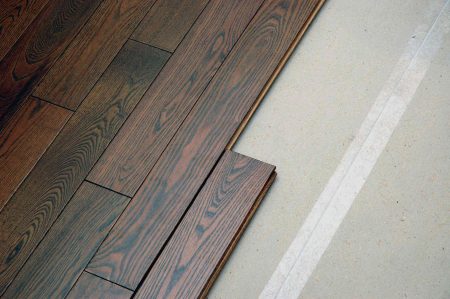Concrete is a tough, durable material that is both long-lasting and relatively versatile, but over time the soil under the concrete can erode, leaving gaps and small voids that cause the concrete to sink or sag in places.
Instead of completely replacing the slab, you can invest in concrete leveling for about $500 to $1,700, with the average being around $1,500.
Joe Gerrior, owner of Gerrior Masonry & Landscaping Construction Corp., says that “the process often requires specialized equipment such as hydraulic pumps and a mix of slurry (a blend of water, sand, cement, and other additives).”
The pros fill the gaps and voids under the concrete by pumping the slurry through small holes that are drilled in the concrete. This process works stabilize the soil and level the concrete slab. Find out more about concrete leveling costs and methods with this informative guide.
Meet the Expert
Joe Gerrior is the owner of Gerrior Masonry & Landscape Construction Corp., a family-owned business based in Woburn, Massachusetts, serving residential and commercial clients for over 34 years. The company is known for its commitment to excellence in masonry and landscaping services.
Concrete Leveling Cost Factors
Concrete Slab Size
The larger the concrete slab, the more materials will be necessary to complete the project, increasing the material cost. Larger concrete slabs will often take longer to work with, causing the labor costs to increase.
Typically, if you were having the concrete slab mudjacked, then it would cost about $3 to $6 per square foot. However, if you were looking for a more permanent solution, then you may choose to have the concrete slab poly leveled, in which case the cost would increase to $5 to $25 per square foot.
Want more home reno project tips and inspiration? Sign up for our free daily newsletter for the latest how-tos, reno guides, and more!
Materials
Common material options for concrete leveling include a stone slurry, concrete slurry, sand-based cement slurry, or polyurethane foam.
- Stone slurries involve a mixture of compacted stones and a water-based concrete. This type of concrete leveling material helps to improve the strength and stability of the soil that supports the concrete slab, though it costs about $7–$25 per square foot.
- Concrete slurry is typically used for mudjacking. It is made up of a mud-like mixture of cement, water, soil, and sand. This material is the most cost-effective options, so you only need to spend about $3 to $6 per square foot for mudjacking.
- Sand-based cement slurries are often used in areas where the soil is relatively damp. This material is made with dry limestone sand mixed with water, then it’s pumped in from the sides of the concrete slab for about $3 and $8 per square foot.
- Polyurethane foam is used for poly leveling or foam leveling. The process is similar to mudjacking, but instead of a concrete slurry, the pros use polyurethane foam, which expands into the gaps and voids to level the sunken concrete. To fix the concrete slab using this material, homeowners should budget for about $5 to $25 per square foot.
Labor
In most cases, concrete leveling doesn’t take a lot of time, so labor will usually cost about $350 for a 100 square foot project. This labor fee includes mixing and pouring the leveling compound, drilling the concrete slab, and patching any holes after the job is complete.
Project Type
Concrete leveling a driveway will typically cost more than leveling a sidewalk or patio. This is generally due to the difference in size and thickness of the concrete slab, but can also be affected by the amount of material required or the method used to level the concrete.
While poly leveling is a great choice for important support structures, like the foundation or the garage slab, homeowners may only need to invest in mudjacking for smaller concrete slabs, like pathways, steps, or patios.
- Foundation: $4,500 to $10,000
- Driveway: $600 to $3,000
- Sidewalk: $150 to $800
- Garage: $500 to $2,500
- Patio: $500 to $1,100
- Steps: $200 to $600
Additional Concrete Leveling Costs
Concrete Core Drilling
Concrete core drilling is the process of drilling holes or channels through the concrete to allow the masonry pros to pump in a slurry or foam to level the concrete slab. Depending on the size of the slab, the concrete leveling crew may need to drill additional holes, which can increase the cost of the job by as much as $11 per square foot, or about $1,100 for a 100 square foot concrete slab.
Concrete Surface Grinding
After leveling the slab, you may notice that there are some parts of the concrete that are uneven. The masonry pros can address this issue by grinding down the surface of the concrete using an abrasive grinding tool. Concrete surface grinding comes at an additional cost of about $3 to $12 per square foot.
Concrete Polishing
Once the concrete slab is level and any uneven areas are taken care of with surface grinding, you can ask the masonry pros to polish the concrete floor. Polishing helps to hide any patches or areas where concrete core drilling was necessary to level the slab. Plan to spend around $3 to $15 per square foot for professional concrete polishing.
Concrete Leveling Methods
Mudjacking
One of the more basic options for concrete leveling is known as mudjacking. This involves creating a mixture of dement, water, soil, and sand, then drilling two-inch wide holes through the concrete slab and pumping the slurry into the gaps and voids below to lift the concrete slab up to it’s original height.
Generally, mudjacking last about five to 10 years before the slab will need to be leveled again. However, you will only spend about $3 to $6 per square foot, making mudjacking the most affordable choice.
Sandjacking
Sandjacking doesn’t require the masonry professional to drill through the concrete slab. Instead, a mixture of dry limestone sand and water is used to make a slurry that can be pumped into the gaps and voids from the sides of the concrete slab.
This also means that sandjacking works best in areas where the soil is wet. Plan to spend between $3 and $8 per square foot for professional sandjacking.
Poly Leveling
Poly leveling is also known as foam leveling because it uses polyurethane foam to level the concrete instead of relying on a concrete, sand, or stone slurry. The contractors will drill through the concrete slab, similar to mudjacking, then they will inject polyurethane foam into the gaps and voids under the slab. The foam expands in the space, stabilizing the soil and leveling the concrete.
Using this method, you can expect the repair to last for over a decade, though at $5 to $25 per square foot, poly leveling is substantially more expensive than mudjacking or sandjacking.
Stone Slurry Grout Concrete Leveling
When the concrete slab requires a firm base to help support substantial weight, like an oversized truck or multiple cars, then stone slurry grout concrete leveling is a good option. The slurry that is pumped into the gaps and crevices under the slab is made by combining compacted limestone with a water-based concrete. The slurry fills any uneven areas and creates a strong foundation under the slab, though the cost for this service can be higher than poly leveling, with a price range from $7–$25 per square foot.
DIY vs. Professional Concrete Leveling Costs
Typically, DIYers with the right tools and materials can fix minor concrete slab problems, like leveling several patio stones or repairing an uneven walkway. However, the larger the concrete slab, the longer it will take and the less likely that the average DIYer will be able to complete the project without problems.
“Potential issues during concrete leveling include improper slurry injection, which can lead to further shifting, or using substandard materials that don’t provide long-lasting support,” Gerrior says. “Hiring a professional is essential for ensuring the job is done correctly, preventing future settling, and avoiding potential voids under the concrete.”
A crew of trained professionals will ensure the work is completed to a higher level of quality than a single DIYer could achieve on their own. Additionally, the pros will often offer a warranty or guarantee on the work.
Replacing vs. Leveling Concrete
Concrete leveling isn’t always an option. Generally, if the concrete is too thin, brittle, or too heavily damaged, then the contractor will need to break up the slab, haul away the old concrete, then pour a new slab to replace what was removed.
Concrete replacement costs more than concrete leveling and also takes more time and effort to complete. For these reasons, it’s best to use concrete leveling whenever possible to repair existing concrete slabs.
Best Time of Year to Save Money on Concrete Leveling
Concrete leveling will typically take place during spring, summer, and early fall when the weather is relatively nice. To get better prices for this work, try to book the project for early spring, late fall, or even into early winter, when the demand for concrete leveling services is at it’s lowest.
-
Is concrete lifting worth it?
Concrete lifting is definitely worth the investment. As long as the job is done properly, concrete lifting is more efficient and affordable than simply replacing the concrete slab, and tends to take less time.
-
How long does concrete leveling last?
It depends on the concrete leveling method. While mudjacking will only last about five to 10 years, poly leveling can last well over a decade before the concrete will need to be leveled again.
-
Will self-leveling concrete crack?
Self-leveling concrete can crack, though this depends on the bonding and movement of the concrete slab. If the self-leveling concrete does not bond well or the concrete slab moves or shifts, then there is a chance that the self-leveling concrete will crack.
Read the full article here
